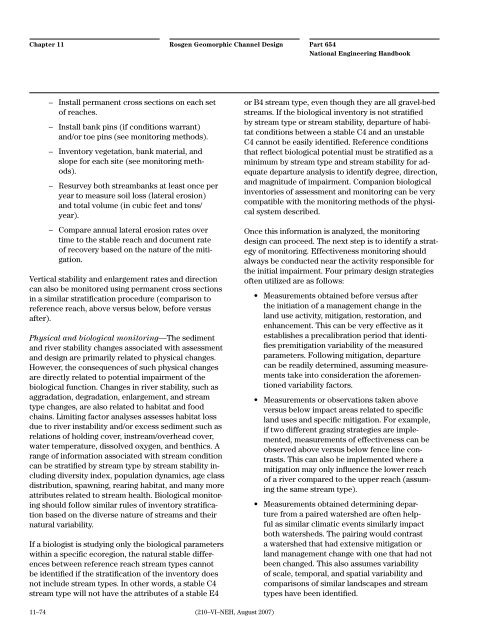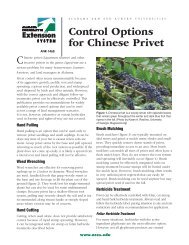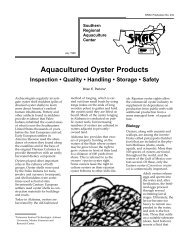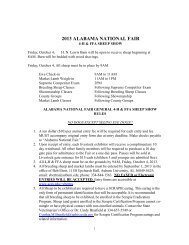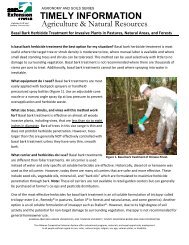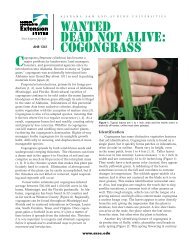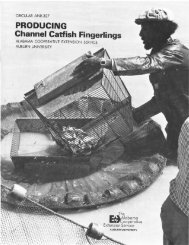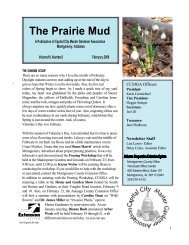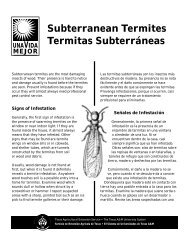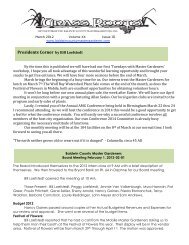Chapter 11--Rosgen Geomorphic Channel Design
Chapter 11--Rosgen Geomorphic Channel Design
Chapter 11--Rosgen Geomorphic Channel Design
Create successful ePaper yourself
Turn your PDF publications into a flip-book with our unique Google optimized e-Paper software.
<strong>Chapter</strong> <strong>11</strong><br />
– Install permanent cross sections on each set<br />
of reaches.<br />
– Install bank pins (if conditions warrant)<br />
and/or toe pins (see monitoring methods).<br />
– Inventory vegetation, bank material, and<br />
slope for each site (see monitoring methods).<br />
– Resurvey both streambanks at least once per<br />
year to measure soil loss (lateral erosion)<br />
and total volume (in cubic feet and tons/<br />
year).<br />
– Compare annual lateral erosion rates over<br />
time to the stable reach and document rate<br />
of recovery based on the nature of the mitigation.<br />
Vertical stability and enlargement rates and direction<br />
can also be monitored using permanent cross sections<br />
in a similar stratification procedure (comparison to<br />
reference reach, above versus below, before versus<br />
after).<br />
Physical and biological monitoring—The sediment<br />
and river stability changes associated with assessment<br />
and design are primarily related to physical changes.<br />
However, the consequences of such physical changes<br />
are directly related to potential impairment of the<br />
biological function. Changes in river stability, such as<br />
aggradation, degradation, enlargement, and stream<br />
type changes, are also related to habitat and food<br />
chains. Limiting factor analyses assesses habitat loss<br />
due to river instability and/or excess sediment such as<br />
relations of holding cover, instream/overhead cover,<br />
water temperature, dissolved oxygen, and benthics. A<br />
range of information associated with stream condition<br />
can be stratified by stream type by stream stability including<br />
diversity index, population dynamics, age class<br />
distribution, spawning, rearing habitat, and many more<br />
attributes related to stream health. Biological monitoring<br />
should follow similar rules of inventory stratification<br />
based on the diverse nature of streams and their<br />
natural variability.<br />
If a biologist is studying only the biological parameters<br />
within a specific ecoregion, the natural stable differences<br />
between reference reach stream types cannot<br />
be identified if the stratification of the inventory does<br />
not include stream types. In other words, a stable C4<br />
stream type will not have the attributes of a stable E4<br />
<strong>Rosgen</strong> <strong>Geomorphic</strong> <strong>Channel</strong> <strong>Design</strong><br />
<strong>11</strong>–74 (210–VI–NEH, August 2007)<br />
Part 654<br />
National Engineering Handbook<br />
or B4 stream type, even though they are all gravel-bed<br />
streams. If the biological inventory is not stratified<br />
by stream type or stream stability, departure of habitat<br />
conditions between a stable C4 and an unstable<br />
C4 cannot be easily identified. Reference conditions<br />
that reflect biological potential must be stratified as a<br />
minimum by stream type and stream stability for adequate<br />
departure analysis to identify degree, direction,<br />
and magnitude of impairment. Companion biological<br />
inventories of assessment and monitoring can be very<br />
compatible with the monitoring methods of the physical<br />
system described.<br />
Once this information is analyzed, the monitoring<br />
design can proceed. The next step is to identify a strategy<br />
of monitoring. Effectiveness monitoring should<br />
always be conducted near the activity responsible for<br />
the initial impairment. Four primary design strategies<br />
often utilized are as follows:<br />
• Measurements obtained before versus after<br />
the initiation of a management change in the<br />
land use activity, mitigation, restoration, and<br />
enhancement. This can be very effective as it<br />
establishes a precalibration period that identifies<br />
premitigation variability of the measured<br />
parameters. Following mitigation, departure<br />
can be readily determined, assuming measurements<br />
take into consideration the aforementioned<br />
variability factors.<br />
• Measurements or observations taken above<br />
versus below impact areas related to specific<br />
land uses and specific mitigation. For example,<br />
if two different grazing strategies are implemented,<br />
measurements of effectiveness can be<br />
observed above versus below fence line contrasts.<br />
This can also be implemented where a<br />
mitigation may only influence the lower reach<br />
of a river compared to the upper reach (assuming<br />
the same stream type).<br />
• Measurements obtained determining departure<br />
from a paired watershed are often helpful<br />
as similar climatic events similarly impact<br />
both watersheds. The pairing would contrast<br />
a watershed that had extensive mitigation or<br />
land management change with one that had not<br />
been changed. This also assumes variability<br />
of scale, temporal, and spatial variability and<br />
comparisons of similar landscapes and stream<br />
types have been identified.


